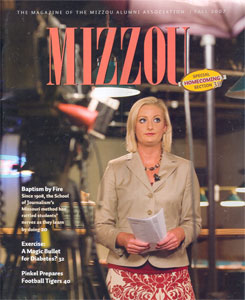Journalism School Makes Headlines in University’s Alumni Magazine
Columbia, Mo. (Sept. 17, 2007) — The Missouri School of Journalism made some headlines of its own recently when MIZZOU, the magazine of the Mizzou Alumni Association, featured it with three separate articles in its fall edition.

The reason for the coverage, editor Karen Worley, BJ ’73, said, is to feature the School’s centennial celebration and dedication of the Donald W. Reynolds Journalism Institute, scheduled for Sept. 10-12, 2008. The world’s first school of journalism began Sept. 14, 1908, when student reporters and faculty editors published the first issue of the Columbia Missourian, a novel hands-on newspaper lab. A century later, the School will be opening the doors of the new Reynolds Journalism Institute, a $31 million center for modern and emerging media.
“There are many Mizzou Mafia members in our alumni magazine audience,” Worley said. “For graduates of other schools and colleges, I hope they enjoy knowing more about one of the University’s oldest and finest programs.”
Crafting Journalism’s Future
In the first article, writer Dale Smith takes a look at the changing world of journalism with help from Dean Mills, dean of journalism, who doesn’t mince words in describing the sweeping, and sometimes destructive, impact technology is having on news distribution.
“New technologies are completely obliterating the old one-way model in which authoritative journalists talked to the masses,” he told MIZZOU.
These new technologies, many of them supported by the growth in popularity of the Internet, are the cornerstone of the School’s plan to update its curriculum for the 21st century, Mills said. Central to that planning is a recently added convergence area of study, which combines multiple journalism disciplines, and the opening of Reynolds Institute.
Founded in 2004, the Institute will occupy three campus buildings – Walter Williams Hall, the former sociology building and a new structure linking them. Its purpose will be to help re-invent journalism with new technology and to serve as an idea factory for future developments in journalism.
“The idea for the Institute comes from the conviction that there is a rupture between citizens and journalists,” Mills told MIZZOU. “The result has been that we have core functions of democracy – dissemination of information, stimulation of debate – that are no longer respected by many citizens.”
Mastering the Missouri Method
In the second article, writer John Beahler takes a look at the innovative ideas that launched, and still maintain, the world’s first journalism program.
From the very first day in 1908, the School has emphasized the value of hands-on experience. That is why, almost 100 years later, the School still ranks consistently as one of the top two or three best journalism programs in the world.
George Kennedy, professor emeritus of journalism, told MIZZOU that the School continues to rank highly because it was a pioneer in journalism education when other institutions – particularly those in the Ivy League – underestimated its importance.
“The secret to Missouri’s longtime success and the best indicator that Walter Williams – whatever his personal shortcomings may have been – was a genius, is that the system he created, the learning by doing, has held up for darn near 100 years now, pretty much regardless of who the people were with the levers in their hands,” Kennedy told MIZZOU.
Books in the Big Apple
In the third article, Steve Weinberg, professor of magazine journalism, tells the fascinating life story of George Hodgman, BJ ’81, who climbed from small-town Missouri to the top of New York’s publishing industry.
After earning his undergraduate degree from the Missouri School of Journalism, Hodgman enrolled in the graduate program at Boston College, where he earned a master’s degree in English and American literature in 1983.
With his formal education behind him, he set off to start his career, working his way up from dubious positions editing computer books and writing for a stock brokerage firm before finally landing an entry-level job at publishing giant Simon & Schuster. That was the toehold that launched a dazzling career in publishing.
Hodgman has held prestigious jobs at Vanity Fair, appeared on ABC’s Good Morning America and worked briefly at Talk magazine, a pet project of Tina Brown, the former editor of The New Yorker magazine. Hodgman also found time to write some of his own stories, freelancing for publications such as Harper’s Bazaar and Entertainment Weekly. He currently works at Houghton Mifflin.
The fall 2007 edition of MIZZOU also is the launching pad for the magazine’s new Web site, http://mizzoumag.missouri.edu/. The journalism features will be available on the Web site in late October.
Updated: April 28, 2020